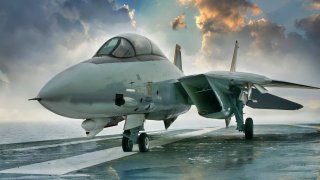The U.S. Navy's F-14 Tomcat Could Go Into 'Bomber Mode'
The F-14 Tomcat, famed for its air superiority and iconic role in the movie "Top Gun," was also capable of air-to-ground combat—a facet less known to the public. Equipped with the AWG-15 fire-control system featuring a constantly computed impact point (CCIP) mode, the F-14 could deploy unguided bombs from its inception.
What You Need to Know: The F-14 Tomcat, famed for its air superiority and iconic role in the movie "Top Gun," was also capable of air-to-ground combat—a facet less known to the public. Equipped with the AWG-15 fire-control system featuring a constantly computed impact point (CCIP) mode, the F-14 could deploy unguided bombs from its inception.

-Interestingly, Iran was the first to utilize the Tomcat in a ground-attack role during the Iran-Iraq War, adapting it as a 'bomber.'
-In the late 1980s, the U.S. Navy began exploring this capability, leading to the "Bombcat" evolution where the F-14 deployed GBU, JDAM, and Mk-82 bombs. Despite its versatility, the F-14 remains best remembered as a premier air superiority fighter.
The F-14 Tomcat: Beyond Top Gun—Its Ground-Attack Capabilities Unveiled
The F-14 Tomcat is an iconic swept-wing fighter. Once the U.S. Navy’s primary fighter, the F-14 transcended the realm of military aviation to gain recognition amongst the general public thanks to 1986’s top-grossing film, Top Gun. In Top Gun, Tom Cruise and Val Kilmer pilot the F-14 – but they do so in just one capacity: air-to-air combat; never is the F-14’s capacity as an air-to-ground aircraft displayed, which no doubt feeds into the misconception that the F-14 was exclusively an air-to-air fighter, like its Air Force contemporary the F-15A-D.
Yet, the F-14 was capable of performing an air-to-ground role.
Tom Cooper reports, “even though the Tomcat performed the air-to-ground role only in her twilight years, the AWG-15 fire-control system of the F-14A Tomcat was always equipped with the constantly computed impact point (CCIP)-mode, and the jet was always capable of deploying ‘dumb’ bombs.”
Curiously, the Iranians were the first to deploy the F-14 in bomber mode.
Yes, the Iranians imported the F-14 back before the Iranian Revolution, when the U.S.-installed Iranian government and the U.S. were still on good terms in the 1970s. Then, at war with Iraq through most of the 1980s, the post-Revolution Iran deployed the F-14 as a ‘bomber.’
In America, the F-14 was used exclusively as an interceptor for decades.

“The idea about the F-14 being a ‘pure interceptor’…became a dogma,” Cooper wrote. Yet, eventually, Navy decision makers, “came to their senses” in realizing “it was no problem for U.S. Navy’s F-14-units to (re-) start ‘flight testing’ and even do some training in release of bombs, in the late 1980s – thus opening the way for what eventually evolved into the ‘Bombcat.’”
But of course, the F-14 is best remembered for its use as an air superiority fighter. Iran, again, can claim most of the F-14s air-to-air kills, as Iran used the jet extensively in the Iran-Iraq War. But the U.S. has a few F-14 air-to-air kills, too.
In 1981, US F-14s shot down two Libyan Su-22 fighters over the Gulf of Sidra in the Mediterranean. The Su-22s opened fire on the F-14s. A mistake; the Su-22s were ill-equipped to compete with the Navy’s then-preeminent air superiority fighter. In 1989, U.S. F-14s again engaged with enemy aircraft over the Mediterranean, two MiG-23s.
Again, the F-14s were successful against the inferior Soviet-made aircraft. Then, during the Gulf War the F-14 was deployed extensively, yet only came away with one air-to-air kill, which happened to be against an Mi-8 helicopter. The Iranians meanwhile racked up fifty-five confirmed air-to-air kills in the F-14, although 150 are claimed.
The F-14, towards the end of its Thirty year U.S.Navy career, did began dropping bombs, namely the GBU, JDAM, and Mk-82. But the jet will always be remembered as an air superiority fighter. And most of all, the jet will always be remembered for cat-launching into the sunset, with Danger Zone blasting.
About the Author: Harrison Kass
Harrison Kass is a defense and national security writer with over 1,300 total pieces on issues involving global affairs. An attorney, pilot, guitarist, and minor pro hockey player, Harrison joined the US Air Force as a Pilot Trainee but was medically discharged. Harrison holds a BA from Lake Forest College, a JD from the University of Oregon, and an MA from New York University. Harrison listens to Dokken.
Image Credit: Creative Commons and/or Shutterstock.


